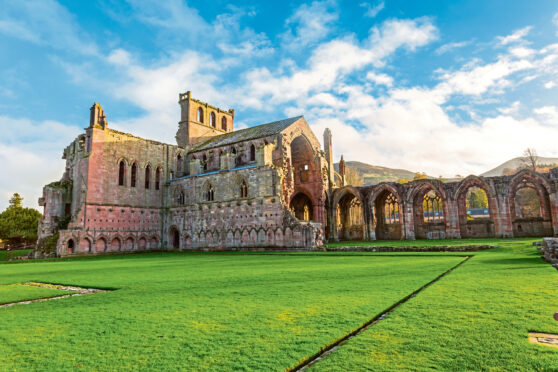
The four Great Borders Abbeys of Melrose, Kelso, Jedburgh and Dryburgh stand as testament to the monks who journeyed from Europe, spreading word of their faith.
Founded in the 12th and 13th Centuries, the exquisite buildings they left behind have been revered by visitors from the world over.
The abbeys are looked after by Historic Environment Scotland, where Adrian Cox is senior cultural resources advisor.
“They are hugely important,” Adrian says. “Each contributes to an understanding of monastic life.”
You can wander around the grounds of the abbeys, with Melrose the best preserved. It was founded in 1136 by Cistercian monks at the request of David I of Scotland.
The heart of Robert the Bruce is believed to be buried in the chapter house and the Commendator’s House Museum holds a rich collection of medieval objects.
“Melrose Abbey not only displays magnificent architecture,” Adrian says, “but is also the place where the Chronicle Of Melrose was composed, providing important historical evidence.”
Strange tales from the abbey’s history include stories of vampire monks – and even a wizard. You can find out more on the audio tour.
Kelso Abbey was one of Scotland’s wealthiest religious houses, but it suffered the wrath of Henry VIII in the 1540s, leaving it in ruin.
Jedburgh Abbey combines an unusual mix of Gothic and Romanesque architecture, built over 70 years.
Visit the nave where Alexander III was married in 1285 – according to legend, a ghost appeared at the ceremony, foretelling the king’s death. Alexander died less than a year later after a fall from his horse.
You can climb to the walkways of Jedburgh’s chapter house for a bird’s-eye view of the dormitories.
Last, but by no means least, on your tour of the Borders’ Great Abbeys is Dryburgh. Despite three fires and four attacks over the centuries, it is remarkably intact.
In the chapter house there is even original paintwork dating back to the abbey’s construction in 1150.
“Look out for the important graves at Dryburgh,” Adrian says, “including that of Sir Walter Scott.”
As you explore, keep an eye out for the abbey’s resident ghost, inexplicably called “Fat Lips”. A woman who stayed here in the 18th Century claimed Fat Lips, a little man in iron boots, tidied her cell for her.
Whether you catch a glimpse of any benevolent spirits or not, a visit to the majestic Borders Abbeys is a spiritual, humbling experience.
Don’t miss: There are many notable graves at Dryburgh, chief among them that of Sir Walter Scott – look out for his famous resting place.

Enjoy the convenience of having The Sunday Post delivered as a digital ePaper straight to your smartphone, tablet or computer.
Subscribe for only £5.49 a month and enjoy all the benefits of the printed paper as a digital replica.
Subscribe